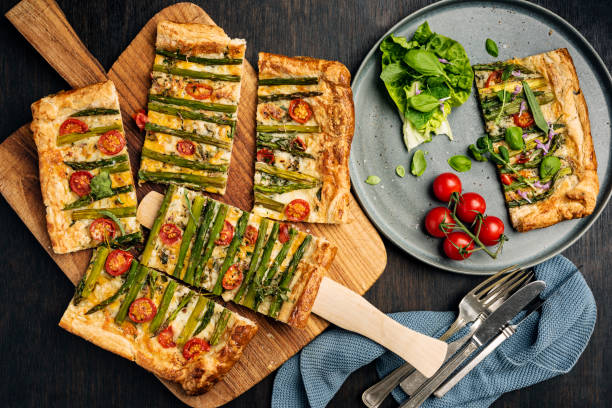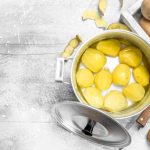What’s the best simple recipe? We have a variety of reasons to like to suggest quiche as the best quiche it’s delicious with any food item of the day. It is made from only a handful of ingredients from your kitchen and can be infinitely customizable based on the mix-ins you’ve got in your pantry. Unsurprisingly, this dish is a top choice on brunch menus worldwide and can be used as an easy meal for a weeknight.
However, if the quiche you make at home gets soggy and less than memorable results, You may need to adjust your recipe. We asked professionals across the country and shared their best tricks for making a better quiche. Take eggs, cream, cheese, and veggies, and prepare to bake something delicious.
Blind Bake the Crust
The flaky, crispy crust is among the finest elements of quiche. “But to achieve that tasty outer layer, you need to bake your naked crust a little before adding the egg mixture,” says Zakari Davila head chef of Willa’s in Tampa, Florida. This helps to prevent it from becoming watery. Davila recommends the blind bake of your pie to 350 F for 7 minutes, in addition to your overall baking time. Utilize expert pie weighers to ensure that there are no bubbles in the crust, but any kind of dried beans added to the crust can also be used. Before making the filling with the egg mixture, pour them out after seven minutes (and ensure you don’t use the beans again).
Use a Great Dough
“While any basic pie dough recipe (or even store-bought dough) will do in a pinch, the number one way to make delicious quiche is to make a homemade pate brisee dough,” says Andrew Zimmerman, executive chef at Sepia and Proxi in Chicago. (The primary difference between this and traditional American pie crusts is the fact that pate Brisee includes a small amount of sugar that is caramelized in hot temperatures, resulting in an intense golden hue and an occasional crunch when baked. It’s also more supple than the traditional pie crust due to the technique of mixing it with the fingertips of your hand, known as dressage.)
Make sure to let the dough prior to rolling it out. You can do this again before blind baking it. If you don’t do this your crust will become stiff and shrink during your blind bake.
Chill It
“Though most people know to do this when baking pies, chilling the dough is a step that often gets overlooked when making quiche,” says Qi Ai, chef de cuisine at Travelle at The Langham in Chicago. “Work fast when preparing your dough so you don’t warm up the butter too much–you should still be able to see some butter pieces in the dough, as they will form the flaky layers during baking,” Ai says. The dough should be chilled for an hour prior to rolling out your crust.
Add Another Layer of Protection
“After blind baking your crust, create a waterproof barrier protecting it from the moisture of your filling by brushing it with a thin layer of egg wash,” Ai suggests. “Return the crust to the oven for another three to five minutes after doing this to bake off the egg before adding your filling and baking according to your recipe.”
Whip Your Eggs
This helpful suggestion comes from Victoria Dearmond, pastry director for Underbelly Hospitality in Houston can help you make your quiche soft and creamy. “Add your eggs to a bowl, then whisk them for about 3 minutes (or use a hand mixer) before adding heavy cream. Whip the mixture again for about 4 minutes before adding your other ingredients and pouring everything into your crust.” (Dearmond states that she’ll use around six eggs and a teaspoon of cream for a traditional quiche.)
Cook the Veggies First
“Vegetables will take longer to cook than your egg custard, so always saute onions, steam broccoli, etc. before you add them to your egg mixture to ensure every bite of quiche will be perfectly cooked,” says Kristin Berenson, Executive Chef of Henley Nashville. Nashville.
Avoid Fillings That Are Too Wet
“Some vegetables, such as sliced large tomatoes or raw zucchini, have a high water content and will make your quiche soggy (even if you follow all steps to avoid this! ),” Davila mentions. Instead, he suggests roasting vegetables like mushrooms and eggplant before adding them to the egg mix. This helps draw out moisture, and also enhances the flavor of the quiche. If you’re making use of an ingredient like sauteed spinach, make sure to squeeze out the liquid before adding it to the quiche.
Experiment With Flavor Combos
Nathaniel Reid, the two-time James Beard award semifinalist and an owner of a bakery in St. Louis, recommends altering the ingredients you add to your quiche, from veggies and proteins to herbs and cheese, to reflect the changing seasons. A few of his top picks for inspiration for the next batch of quiche include:
Chive, potato and tarragon. They also smoke cheddar.
Ham leek, potato, and other herbs.
The blue crab as well as asparagus.
Dill and salmon smoked.
The oyster mushroom, shallots, and the oyster.
Bacon, caramelized onion and Gruyere.
Opt for Fresh Herbs Over Dried Ones.
Utilizing fresh herb is the best method of enhancing your quiche without much effort. Mix some of them into the base, and then sprinkle some on top once it’s out from the oven. For Dearmond, the most simple quiche to make is eggs and cream with cheese and a lot of chives. “There’s minimal chopping, no chance of veggies overcooking or releasing water into your base, and it can be in the oven in less than 10 minutes,” she says.
Choose the Right Cooking Vessel
“It may sound surprising, but a pie pan isn’t the ideal vessel for baking quiche because it’s not deep enough,” says Zimmerman. Instead, you can use a 2 inch wide springform pan or even two-inch high pastry ring made of steel placed on a baking pan lined with parchment. “This depth allows for more silky custard and less chance of overcooking the quiche,” the chef adds.
Lower the Oven Temperature
A lot of quiche recipes require the oven to be preheated at 350 to 400 F. But, Dearmond recommends cooking quiche with a slightly lower temp (around 325 F) for a little longer, to ensure that you don’t end up with a souffle of eggs. The exact baking time for quiche is difficult to determine because the sizes of pans vary, but it is a good idea to keep in mind that you’ll want the filling to be cooked with a slight movement within the middle. “The custard will continue to cook after you take it out of the oven,” Dearmond states. “So if you pull it out when it’s still a little underdone, it will be perfectly cooked by the time it cools completely.”



